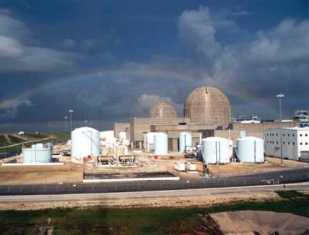 After CPS Energy unveiled its optimistically low $13 billion proposal for South Texas Project reactors three and four, I decided to look into the history of the construction of the first two reactors. What I found was troubling, but it seemed to be pretty much in line with my understanding of problems with nuclear projects during the 70s and 80. Here is a brief time line:
After CPS Energy unveiled its optimistically low $13 billion proposal for South Texas Project reactors three and four, I decided to look into the history of the construction of the first two reactors. What I found was troubling, but it seemed to be pretty much in line with my understanding of problems with nuclear projects during the 70s and 80. Here is a brief time line:
1971: Houston Lighting and Power presents proposal for South Texas Nuclear Project, with an estimated cost of 1 billion dollars for the entire project.
1973: Construction begins, with contractor Brown and Root. A $1 billion cost is agreed upon and the first reactor is projected to be finished by 1980 and the second by 1982.
1979: Brown and Root Inspector Dan Swayze gives interview with CBS Magazine, discussing his decision to stop inspecting concrete pours after a 1977 incident at STP in which concrete workers at STP threatened his life and physically assaulted another inspector. “They beat the hell out of him” -Swayze
1979: Estimated costs rise to $2.7 Billion and completion of the reactors is postponed
to 1984 for the first and 1986 for the second.
1979: Three Mile Island accident. San Antonio reevaluates its role in the project.
1980: After 3,000 complaints reports of work deficiencies, the Nuclear Regulatory Commission issues a report citing 22 violations and fines HL&P $100,000 and issues a “show cause order” requiring the company to explain why the project should be allowed to continue.
1980: HL&P voluntarily stops work after problems are discovered in the welding and concrete. The projected is rated below average by Ralph Nader’s Critical Mass Energy Project. It is ranked among the top 4 worst ongoing projects.
1981: HL&P fires original contractor Brown and Root (who had no previous experience with nuclear reactors) and replaces them with Bechtel Corporation. Estimated completion costs increase to $4.5 billion.
1985: Brown and Root looses a $750 million law suit, filed by Houston Lighting & Power, San Antonio City Public Service, Central Power, Light of Corpus Christi and the city of Austin. At the time this was the largest cash legal settlement in U.S History.
1987: HL&P receives low-power operating license for Unit 1 nuclear reactor.
1988: The Nuclear Regulatory Commission conducts last minute inspection of facility after hundreds of allegations of poor construction, over 50 of which were made by plant workers through the Government Accountability Project. Among the allegations was a claim that roughly 20% of the plant’s safety valves were installed backwards. This was never corrected after it was concluded that the plant could still function with backwards safety valves.
1988: Completion is announced 7 years late and 500% over budget.
1989: City of Austin files lawsuit against Houston Lighting and Power for unexpected expenses and delays during the construction of STP. Texas Court in Dallas Rules in HL&P’s Favor.
Since 1990: STP and other nuclear plants spend an average of $45 million each year disposing of waste. To clarify that is average is per plant.
CPS energy is giving an optimistically low estimate of the total cost of the project. Estimates that consider the cost overruns and construction delays that plagued STP and similar projects last time peg the plant at no lower than $17 billion. This look at STP’s history provides a good example of what can happen when we don’t recognize the likely additional expenditures an expensive project like this will have and operate on an unrealistic time frame. San Antonio is on the verge of repeating many of the mistakes of the past, and it is the citizens that will have to pay.
The Disappointed Environmentalist
Read Full Post »

 After CPS Energy unveiled its optimistically low $13 billion proposal for South Texas Project reactors three and four, I decided to look into the history of the construction of the first two reactors. What I found was troubling, but it seemed to be pretty much in line with my understanding of problems with nuclear projects during the 70s and 80. Here is a brief time line:
After CPS Energy unveiled its optimistically low $13 billion proposal for South Texas Project reactors three and four, I decided to look into the history of the construction of the first two reactors. What I found was troubling, but it seemed to be pretty much in line with my understanding of problems with nuclear projects during the 70s and 80. Here is a brief time line:

